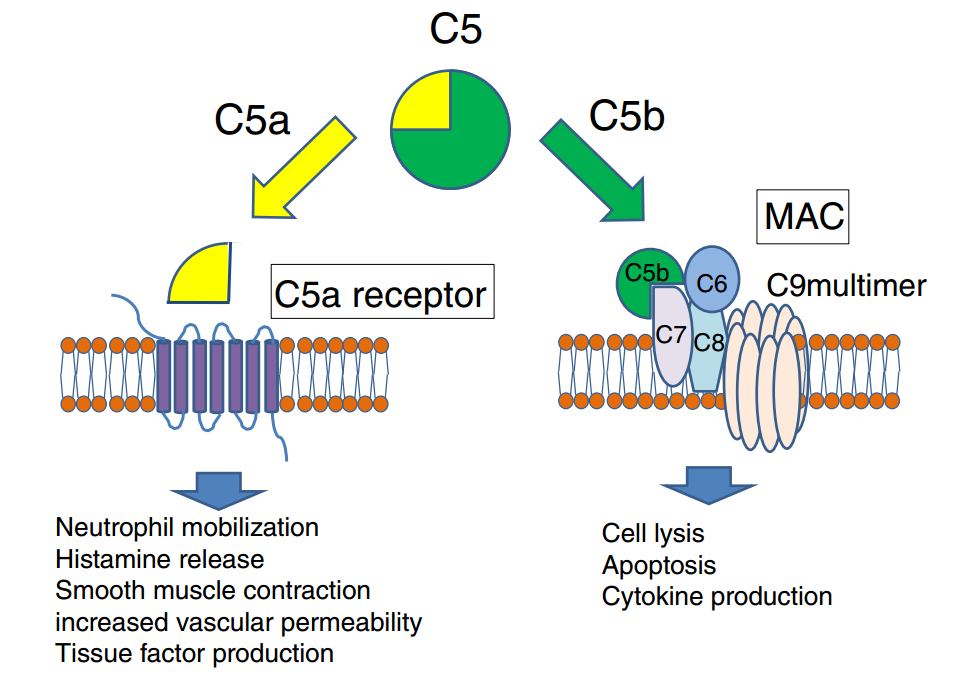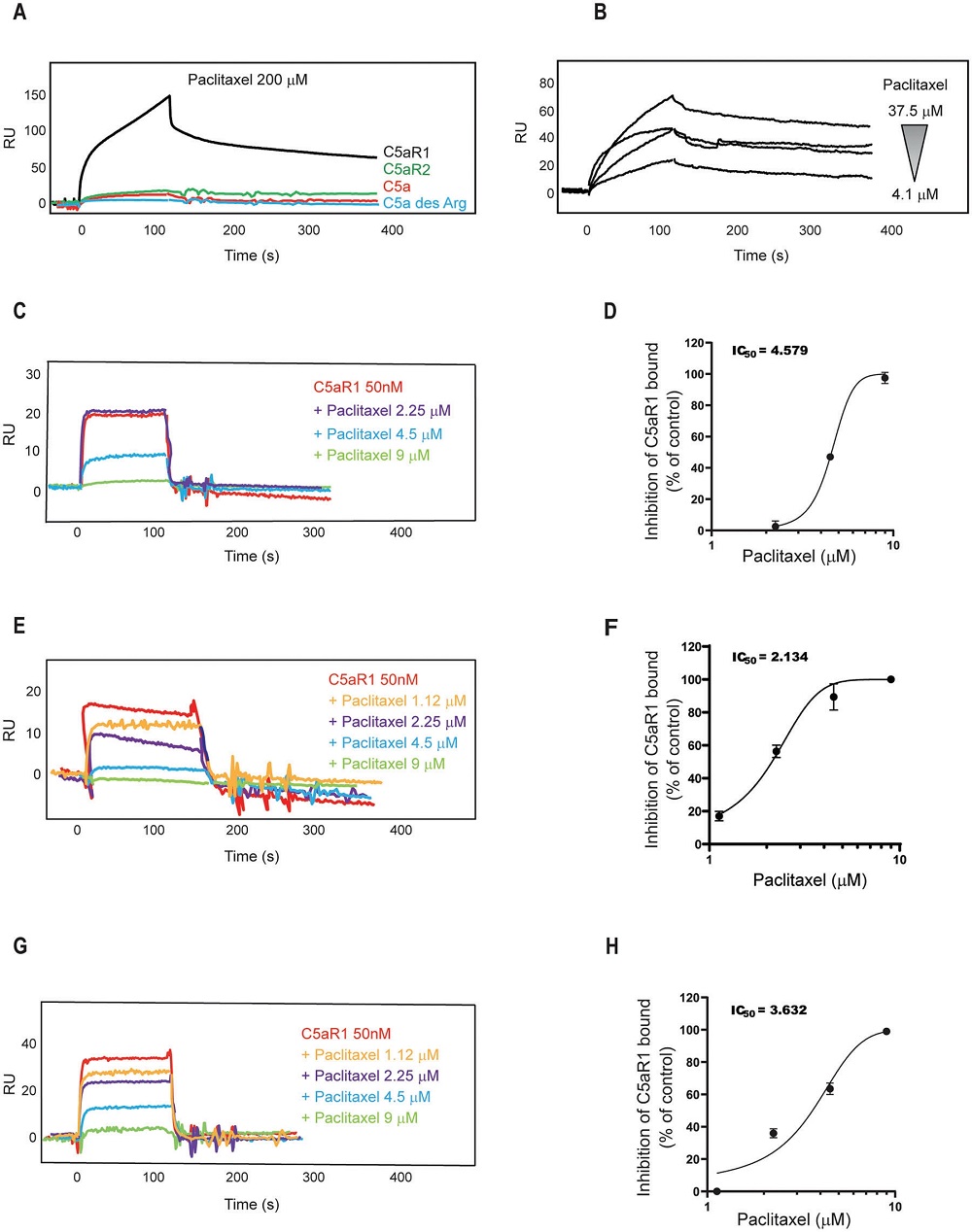Creative Biolabs is an industry leader in the field of drug discovery and antibody development. We are proud to provide antibody, protein, small molecule drug development services for the treatment of a range of diseases caused by excessive or uncontrolled activation of the complement system.
Complement activation serves to eliminate pathogens, but abnormal activation is heavily involved in the pathology of various conditions. Hence, various drugs targeting specific complement components have been explored, among which, the group of therapeutic compounds that target C5aR represents one of the largest developing groups of complement therapeutics and as such is one of the major complement targets of pharmaceutical companies.
C5aR as Complement Therapeutic Targets
Complement component C5a, a type of anaphylatoxins, is one of the most potent effectors generated via cleavage of C5 molecule during complement activation. C5a binds two receptors, C5aR and C5L2. Most of the C5a functional effects occur by binding to C5aRs, a G-protein-coupled signaling receptor that has long been identified as an attractive drug target.
Why Do We Choose C5aR as the Target?
The complement cascade offers points of intervention at almost any level ranging from initiation and primary activation (upstream) to amplification, effector signaling, and lysis (downstream). For complement-related drug discovery, often a careful and disease-specific selection of targets is required due to the diversity of triggering patterns, pathomechanisms, and involved pathways and components. Usually, upstream and downstream therapeutic interventions exhibit different effects on activation and effector mechanisms. An upstream intervention may bring sufficient blockage of disease-causing complement activation but impair preservation of the network’s immune surveillance and homeostatic capacities. In contrast, downstream interventions are often highly effective in suppressing the major clinical manifestations of excessive complement activity while fully preserving key functions like opsonization. Hence, when the downstream C5aR is targeted, a highly selective blockage of pro-inflammatory signaling is achieved.

Fig.1 C5a binds to C5a receptor and mediates various biological activities.1, 3
The Development of C5aR Antagonists
The anaphylatoxin receptor C5aR proves to be a highly important complement target for pharmaceutical companies and the clinical development of antagonists for C5aR is rewarding. To date, a number of peptidic CD88 antagonists, non-peptide antagonists, as well as antibody and natural CD88 inhibitors have been produced. Moreover, agonists, inverse agonists, as well as modified recombinant C5a with dual antagonistic activity for C5aR and C5L2 have also been explored. In summary, C5aR is selected as the intervention point in part due to its potent inflammatory activity with well-documented roles in a wide variety of diseases, as well as the desire to develop drugs which selectively target individual complement components, leaving the remainder of the cascade intact for host defense.
Creative Biolabs offers a full range of complement therapeutic development services for C5aR related disease, such as Alzheimer's Disease to contribute to your project success. Please feel free to contact us for more information or a detailed quotation.
Published Data
 Fig.2 Surface plasmon resonance analysis of Paclitaxel interaction with C5aR1.2,3
Fig.2 Surface plasmon resonance analysis of Paclitaxel interaction with C5aR1.2,3
Hypersensitivity reactions (HSRs) and chemotherapy-induced peripheral neuropathy (CIPN) are common and debilitating adverse effects associated with the antineoplastic drug paclitaxel. This study reveals paclitaxel's binding to and activation of complement component 5a receptor 1 (C5aR1) is pivotal in CIPN and anaphylaxis etiology. In vitro assays confirmed the selective and competitive interaction between C5aR1 and paclitaxel, initiating intracellular signaling via the NFkB/P38 pathway and c-Fos. Inhibition of C5aR1 in neuronal cells and rat dorsal root ganglia alleviated neuropathy induced by paclitaxel. In mice, C5aR1 absence or inhibition improved CIPN symptoms, and reduced chronic pathology. Furthermore, inhibiting C5aR1 reduced cytokine release from macrophages triggered by paclitaxel and ameliorated hypersensitivity reactions in mice, highlighting C5aR1 as a crucial mediator and promising therapeutic target for addressing paclitaxel-induced peripheral neuropathy and hypersensitivity.
References
-
Horiuchi, Takahiko, and Hiroshi Tsukamoto. "Complement-targeted therapy: development of C5-and C5a-targeted inhibition." Inflammation and regeneration 36 (2016): 1-5.
-
Brandolini, Laura, et al. "Paclitaxel binds and activates C5aR1: A new potential therapeutic target for the prevention of chemotherapy-induced peripheral neuropathy and hypersensitivity reactions." Cell death & disease 13.5 (2022): 500.
-
Distributed under Open Access license CC BY 4.0, without modification.
Related Product
Questions & Answer
A: Challenges in developing C5aR-targeted therapies include ensuring the specificity of the therapeutic agents, avoiding potential off-target effects, optimizing dosing regimens, and addressing potential long-term consequences of C5aR modulation. To address these challenges, rigorous preclinical studies and clinical trials are essential to thoroughly characterize the pharmacokinetics, safety profile, and therapeutic efficacy of C5aR-targeted agents. Advanced molecular modeling and structural studies may aid in designing highly specific agents with minimized off-target interactions.
A: Insights gained from studying C5aR's role in tissue-specific inflammation could inform the development of novel targeted therapies beyond C5aR modulation. By elucidating the molecular mechanisms underlying C5aR-mediated immune cell recruitment and tissue damage, researchers may identify key nodes in the inflammatory cascade that could be targeted with precision therapies. These insights could pave the way for the discovery of novel therapeutic targets and the development of innovative treatment approaches for various immune-mediated diseases.
A: The future of C5aR-targeted therapies may involve the refinement of existing agents, development of innovative delivery methods, and exploration of combination therapies that synergistically modulate multiple immune pathways. Advancements in understanding C5aR's intricate signaling networks, along with the application of advanced technologies such as CRISPR-Cas9 gene editing, could pave the way for more precise and effective therapeutic interventions. Additionally, ongoing research into the broader roles of C5aR in various disease contexts may reveal new opportunities for therapeutic exploitation.
For Research Use Only.
Related Sections:


 Fig.2 Surface plasmon resonance analysis of Paclitaxel interaction with C5aR1.2,3
Fig.2 Surface plasmon resonance analysis of Paclitaxel interaction with C5aR1.2,3